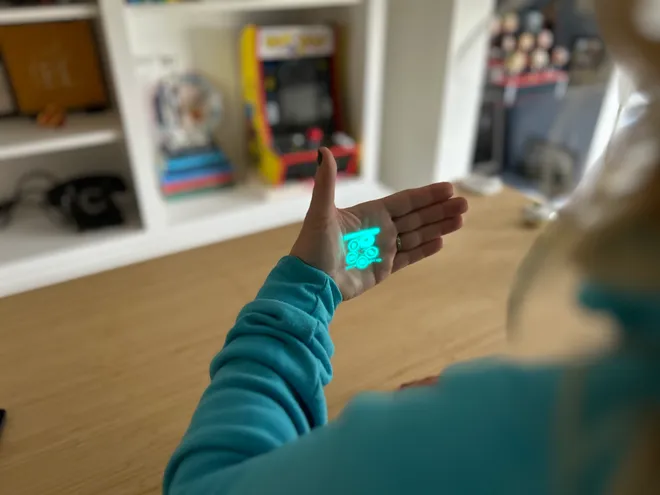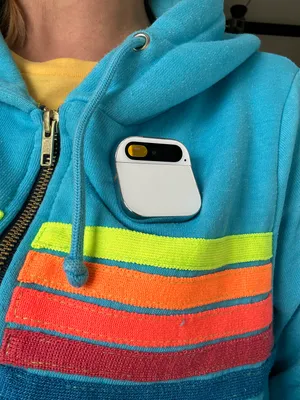The Humane AI Pin is unlikely to soon replace the smartphone but it has some wow features
Can a futuristic artificial intelligence wearable do everything your smartphone does without making you glance at its addictive screens and apps – hundreds if not thousands – of times a day?
In a time when more people feel burned out by how many hours they spend on smartphones, the Humane AI Pin promises to do just that.
It’s a tiny wearable that attaches to your clothes and turns on only by an “intentional” tap of your finger. From there, the idea is to use it like a second brain to remember important info like your passport number or engage it like the most brilliant, most in-tune-with-you personal assistant you could ever imagine.
“You can use it to make calls, send text messages, check up on notifications, capture moments (take a photo or video), interpret other languages, recommend a nearby restaurant, and play music,” Humane CEO and former Apple engineer and executive Bethany Bongiorno explained the first time we met in New York last December. “It lets you interact with AI, but in a way that allows you to be present and in flow.”
“It works by using natural language, touch on the touchpad, and gestures and is capable of doing just about everything you can do on a conventional phone, with a lot of new ways to bring in things you see around you –contextual compute – when you want it,” Humane’s other co-founder and former Apple inventor and designer, Imran Chaudhri, explained. (Chaudhri and Bongiorno are a husband-and-wife team who met during their tenure at Apple.)
What’s it like to use Humane AI Pin?
I’ve been wearing an early release “beta” of the Lunar white polished chrome model ($799 plus $24 a month for a mobile subscription – the least expensive AI Pin model starts at $699) for about a week now, and wow, is it ever glitchy.
There’s a lot to like about it, and the PR team keeps reminding me it’s a “1.0 product that will continuously get better and evolve,” but here’s what I expected would be different right out of the gate:
You have to touch it to get it to do anything
By design, there’s no “wake word,” which means it’s never truly hands-free.
When the founders told me I could use “Voice Control,” I thought I could use it like Siri or Alexa.
The problem? You have to “gently touch” the device with your finger every time you want to chat, and not just to activate it, either; You have to keep your finger pressed the entire time you’re talking. That’s even less convenient than my smartphone assistant that this pin is trying to replace. I don’t get it.
The one exception is when it takes a 15-second video, which is also the longest video clip you can get at one time for now.
◾ I’ve also had a tough time keeping it charged.
◾ It often overheats and shuts down.
◾ I’ve asked it questions, and it’s given me AI’s weird “hallucination” answers that sound factually correct but aren’t.

It doesn't play Apple Music or podcasts
The only music service it uses is Tidal, and you’ll eventually have to buy a monthly subscription ($11/month). For now, it doesn’t connect with Apple Music or Google Play, though it will let you bring in your contacts from Apple, Google, and Microsoft.
I have a love/hate relationship with the Laser Ink display
With futuristic flair, the device beams its interface onto your upheld palm like a laser pointer. You contort your palm to highlight items or tap your pointer finger to your thumb to select something.

It’s hard to get my hand in the “just right” place for the green display to show up. Bongiorno told me to lift my hand up and down until it became a “muscle memory movement,” which helped, but it’s still wonky.
Reviewed:The best music streaming services in 2024
Touchscreen gestures can be confusing
Learning the taps for the touchscreen is also challenging. I press it too hard or for too long. Or not hard enough. I constantly forget to hold my finger on the device while talking or giving it a command. Unfortunately, most of these gestures aren’t as intuitive as you might imagine.

In its current beta state, the software is a mixed bag, with a few 'wow' features - and a dozen head-scratching omissions
For example, my Pin knows I like healthy food because I told it to remember that information. Neat? Sure, but then I asked it to remind me of something later in the day, and it doesn’t have a time-based reminder feature yet. It also doesn’t sync with any of my current calendars (yet) either. So, it only knows my schedule if I ask it to remember something and then ask it again later if there’s something scheduled for a specific time.
The company promises all these noticeable missing features will come.
Yeah, but aren’t all new gadget launches like this?
Of course, a lot of this is to be expected this early in the lifespan of the “world’s first AI-powered mobile compute device.”
“There can be a learning curve for sure,” Bongiorno told me earlier this week when we spent nearly two hours on a video call troubleshooting the features I couldn’t get to work at first. “For some people, if I look at the data and usage, it’s very fast [to set up and use], and for some people, it takes a little bit longer.”
I’m in the latter camp, and I feel bad about it. Nothing is worse than trying to use a new gadget, and I feel like I must be doing everything wrong.
It’s been a while since I’ve felt that way, and it’s usually because I haven’t read the quick start guide and expect that I’ll charge up whatever it is, follow some set-up prompts, and get right to my review of it. That is the main goal with consumer technology – to be intuitive and straightforward and make our world easier, not harder – isn’t it?
I find it ironic that a gadget engineered to simplify my interactions with technology is so frustrating out of the box.
“Obviously, we need to do a better job with the set-up materials, and we will,’’ Bongiorno said. “That’s why we have this somewhat robust beta testing going on right now. You should see a lot of improvement very quickly.”
Humane AI Pin also has some fantastic features.
I am far from writing this gadget off yet, though. There are things it does that make my jaw hit the floor. (At this point, I keep thinking it would be a stunning $200 iPhone accessory.)
For starters, it works like Siri and Alexa should. It’s faster and more accurate, bringing AI’s best foot forward in a way we haven’t experienced before.
It's the best real-time language translator I've tested to date
“Interpreter on AI Pin allows you to speak and understand over 50+ languages, all with a single touch gesture, allowing you to remain in the moment and maintain eye contact,” Bongiorno promised last December. So far, if I remember the correct gesture – tap and hold two fingers on the touchscreen and remember to keep them there the whole time I’m talking and then again when I’m listening to the response – this works amazingly well. I would consider buying the AI Pin just for this.
Another true appeal of this device – if you’re not drowning in the Silicon Valley hype, at least – is the AI-powered voice commands and natural language question-and-answer features.

The Vision feature blew me away
As advertised, the Pin will tell you what it sees when you say, “What am I looking at?” This is honestly incredible nearly every time I use it. The company calls this feature Vision, and it’s one of those cutting-edge OMGs that point toward a future where you can ask it to look at something and tell you everything you ever wanted to know about it.
That could be amazing for sightseeing or telling you how many calories are in the salad you eat for lunch. Chaudrhi has also teased that you might be able to have it scan an item and then buy it online, though it doesn’t do that yet.
The design is sleek and beautiful
The form factor is another big “pro.” Sure, affixing something about the size of an AirPods case to your shirt is a little strange at first, but within a few minutes, you forget it’s there. It attaches via magnets, which means no garment damage, and after a week or so of wearing it daily, it feels like second nature.
Is Humane AI Pro a smartphone killer?
In the world of consumer tech, it’s a huge deal to be “first.” On that front, Humane AI Pin has already won.
Today’s rollout signals the start of a soon-to-come army of AI-first gadgets for your palm (Rabbit R1 shipping May 23) and face (Brilliant Labs’ AI-enabled Frame glasses ship April 15), and who knows what else.
We’re at the beginning of an AI revolution. It’s happening, and it’s going to be big.
Don’t forget that the smartphone craze arrived alongside the iPhone in 2007. While it certainly changed our world, we almost immediately searched for what would ultimately replace it. Brain implants? Nah. Augmented reality glasses? Not quite. Smartwatches? Almost. A gadget like Humane AI Pin? Now we’re getting warmer.
Jennifer Jolly is an Emmy Award-winning consumer tech columnist and on-air correspondent.
The views and opinions expressed in this column are the author's and do not necessarily reflect those of USA TODAY.
Contact her atJJ@Techish.com.
Disclaimer: The copyright of this article belongs to the original author. Reposting this article is solely for the purpose of information dissemination and does not constitute any investment advice. If there is any infringement, please contact us immediately. We will make corrections or deletions as necessary. Thank you.







